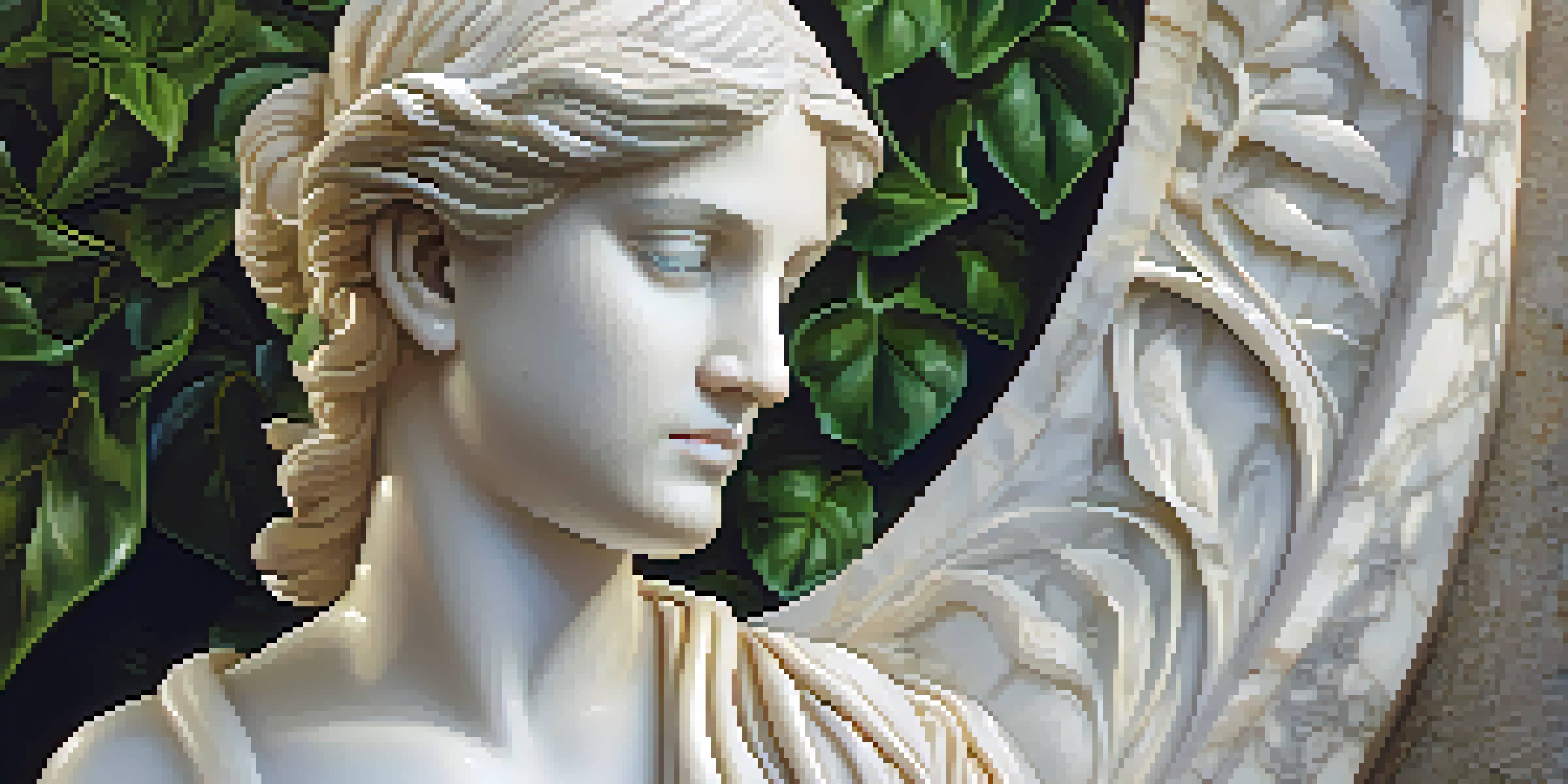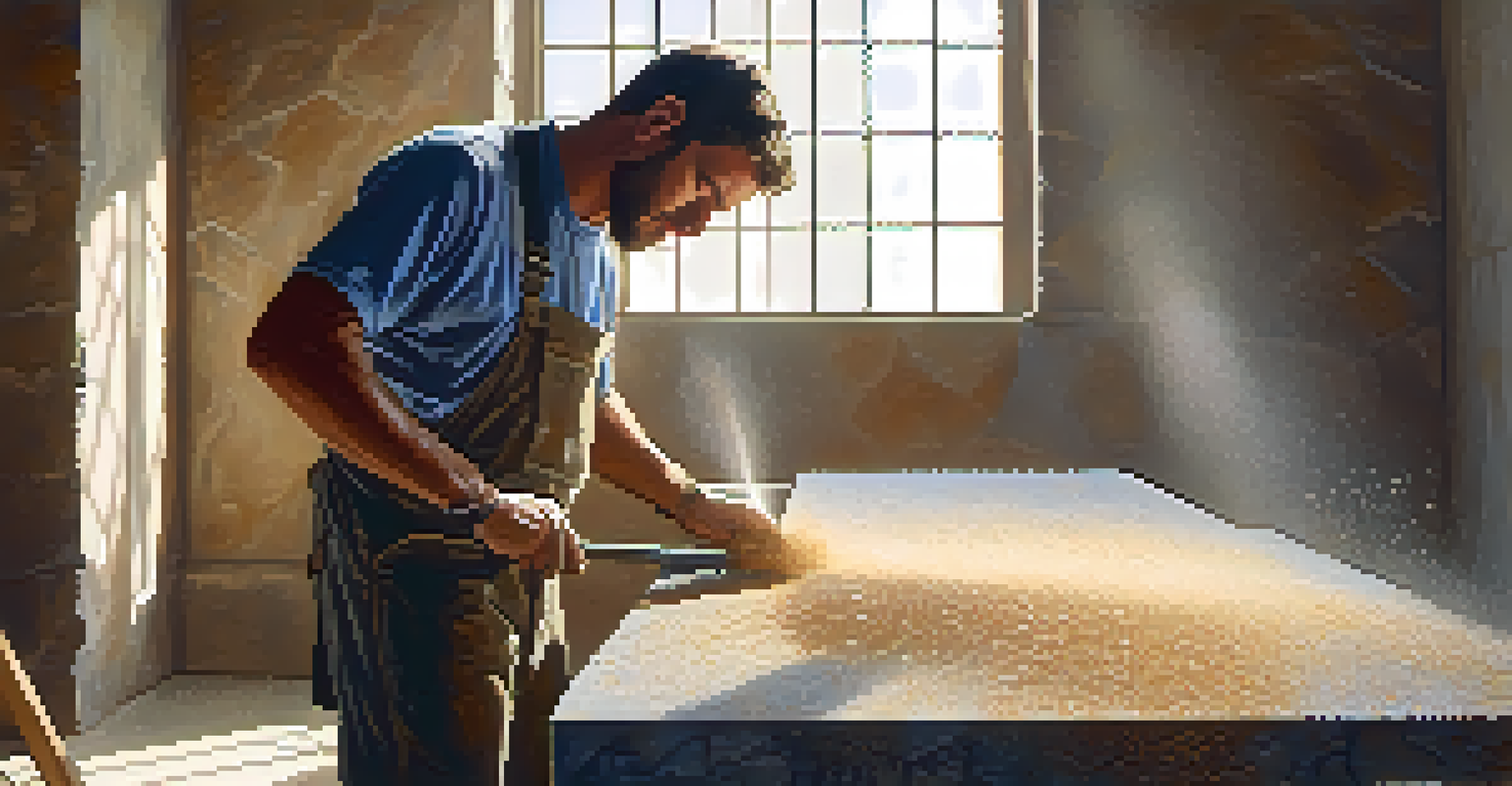Stone Carving Materials: Choosing the Right Stone for Projects

Understanding the Basics of Stone Carving Materials
When diving into stone carving, it's essential to understand the materials available. Stones vary widely in hardness, texture, and appearance, impacting both the carving process and the final product. By familiarizing yourself with these characteristics, you can make informed decisions that suit your artistic vision.
Every artist dips his brush in his own soul, and paints his own nature into his pictures.
For instance, soft stones like soapstone are easier to carve and great for beginners, while harder stones like granite require more advanced tools and techniques. This distinction can significantly affect the time and effort needed for your project. Knowing your options helps you tailor your approach to fit your skill level and desired outcome.
Ultimately, choosing the right stone is about balancing your artistic goals with the practicalities of the material. As you explore different types, consider not just how they look, but how they feel to work with, and how they will hold up over time.
Common Stone Types and Their Characteristics
There are several popular stone types used in carving, each with unique properties. Marble, for example, is known for its beautiful veining and is favored for detailed sculptures. It's relatively soft, making it easier for intricate work, but it can be prone to chipping if not handled carefully.

On the other hand, limestone is another soft stone that is often used for larger projects and architectural elements. Its porosity allows for easier carving, but it may not have the same durability or aesthetic appeal as harder stones. Understanding these nuances helps you decide which type aligns best with your project's needs.
Choose the Right Stone for Carving
Selecting the appropriate stone based on hardness, texture, and availability is crucial for achieving your artistic vision.
Granite, while challenging to work with, offers unmatched durability and a stunning finish. This means that while it might require more advanced tools and techniques, the end results are often striking, making it a favorite for long-lasting monuments. By weighing these factors, you can choose a stone that enhances your artistic expression.
Factors to Consider When Choosing Stone
When selecting stone for your carving project, consider factors like hardness, availability, and cost. Hardness affects how easy or challenging the stone will be to work with; softer stones are more forgiving, while harder stones require more specialized tools. Understanding this can help you gauge the time and effort you'll need to invest.
Art is the most beautiful of all lies.
Availability is another crucial aspect; some stones may be locally sourced, while others may require special ordering. This can influence your budget and timeline significantly. If you're working on a tight schedule, opting for readily available materials might be the best approach.
Lastly, cost can vary widely across stone types. While some may be more affordable, others can be quite pricey due to rarity or unique qualities. Balancing your budget with your artistic vision is key to a successful project, ensuring you get the best materials without overspending.
Tools and Techniques for Different Stone Types
Each type of stone demands specific tools and techniques for effective carving. For softer stones like soapstone, basic hand tools like rasps and chisels often suffice, making it accessible for beginners. This simplicity allows new carvers to focus on honing their skills without overwhelming them with complex equipment.
In contrast, harder stones like granite necessitate power tools and diamond blades to achieve desired results. The investment in these tools can be significant, but they enable precise cuts and finishes that softer stones might not accommodate. Understanding these requirements helps you prepare adequately for your project.
Tools Vary by Stone Type
Different stones require specific tools and techniques, with softer stones needing basic hand tools and harder stones demanding more advanced power tools.
Moreover, the techniques you use will vary based on the stone's characteristics. For example, while you might use a gentle touch with softer materials, harder stones may require more force and different angles. Adapting your approach to the stone type can lead to better outcomes and a more enjoyable carving experience.
The Importance of Stone Texture in Carving
Stone texture plays a significant role in the final appearance of your carved piece. A smooth finish can evoke elegance, while a rougher texture might convey a more rustic feel. Understanding how the texture will interact with light and shadow can help you achieve the desired aesthetic.
For example, polished marble can reflect light beautifully, enhancing the details in intricate carvings. Conversely, unpolished stones add a natural, earthy quality to the work, appealing to those who favor a more organic look. The choice of texture will ultimately influence the emotional response your piece elicits.
Additionally, the texture can affect how the stone behaves during carving. Softer stones may have a more consistent texture, while harder stones may present challenges, like hidden fissures. Being mindful of these factors can lead to more successful carving and a deeper connection to your material.
Environmental Considerations When Selecting Stone
As artists, it's crucial to consider the environmental impact of our material choices. Quarrying practices can vary significantly, with some methods causing considerable disruption to landscapes and ecosystems. By selecting ethically sourced stones, you contribute to responsible artistry that respects nature.
Additionally, thinking about the longevity of your work is vital. Stones that endure over time not only serve as lasting art pieces but also lessen the need for future resources. This consideration helps align your creative expression with sustainable practices.
Consider Environmental Impact
Being mindful of the environmental effects of stone sourcing can enhance the meaning and sustainability of your artwork.
Ultimately, by being mindful of your stone choices, you can create work that resonates not just with viewers, but with the planet as well. This thoughtful approach adds depth to your artistry, making it more meaningful in the broader context of environmental stewardship.
Caring for Your Stone Carvings
Once your stone carving is complete, proper care is essential to ensure its longevity. Different stones have distinct maintenance needs, from regular cleaning to protective treatments. Understanding these requirements can help your artwork withstand the test of time.
For instance, softer stones like limestone may need more frequent sealing to protect against moisture absorption, while granite can often be cleaned with mild soap and water. By knowing how to care for your specific stone type, you can keep your piece looking its best for years to come.

Moreover, considering the location of your carving is crucial. Outdoor pieces may require additional weatherproofing, while indoor sculptures might benefit from dusting and light polishing. Taking these factors into account will help ensure your carving remains a cherished piece of art.